Last Updated on: 15th November 2019, 08:12 pm
Zhangjiajie National Forest Park is one of China’s, and the world’s, most breathtaking natural scenic areas. As China’s first ever national park, Zhangjiajie first opened its doors back in 1982. The huge sandstone pillars which it’s known for, however, were formed many millions of years ago. And most visitors flock to the Yuanjiajie and Tianzi Mountain districts to see them. But for those who prefer quiet, Huangshi Village is also worthy of consideration.
It would probably require at least 5 days to explore Zhangjiajie National Forest Park in full, though many spend 2 days here. I spent three full days hiking through the park, which felt like a good amount of time. Two should be plenty, though, if you choose your hiking routes wisely.
Before my visit, I could only find articles about the park’s main highlights. I really had no idea about which particular hiking courses I could fit into a single day, or the best order to see things in. The staff at my hotel gave me some great tips upon my arrival, but it still would’ve been nice to have access to this info in advance.
That’s why I decided to make a comprehensive guide, divided into three articles, which details some full-day walking routes you can go on during your time at the park. After a day exploring Yuanjiajie and Yangjiajie, I dedicated my second day to Tianzi Mountain. And on my third day, I’d go on to see Golden Whip Stream and Huangshi Village, which you’ll learn more about below.
These guides are intended to give visitors a comprehensive rundown of the important practical info you need to know when visiting the park, together with a virtual walkthrough of the trails and their various highlights.

Zhangjiajie National Forest Park: Essential Info
The following guide is intended for those who like to hike, those who want to make efficient use of their time at the park and also those who like to save money. Before you visit Zhangjiajie National Forest Park, there are a number of important things you should know.
TICKETS: Park entry costs ¥248 RMB and is valid for four days (but double check before your trip, as this has changed in the past). To save time, ask your hotel to pick one up for you in advance so you don’t have to wait in line on your first morning. These are pretty high-tech cards which can only be activated by your fingerprint.
GETTING AROUND: Aside from walking, visitors can get around the park by hopping on free shuttle buses. This is often required to get from one area to another. The park, however, consists of two levels. The lower ground level and the upper mountaintop level. The free buses can only take you from one point to another within the same level. To move from one level to another, you only have two options: hiking or paying extra for cable cars or elevators.
EXTRA FEES: There are various cable cars that cost ¥76 per ride. The massive Bailong Elevator, meanwhile, costs ¥72. And there’s also a tram in the Tianzi area for ¥24. Over the course of three days, I only paid for transport one single time. This was due to time constraints, as visitors must leave the park in the evening.
GENERAL TIPS: The park opens at 7:00 each morning and you should start each day as early as possible. (When traveling in China, it’s amazing how many frustrations you can avoid by following this one simple tip.) It’s best to have some kind of rain jacket or umbrella with you in case of a downpour. And to save some money, buy some snacks in town the night before.
Learn more about transport to the Wulingyuan area and where to stay at the very end of the article.
Huangshi Village Itinerary Summary
Take the bus from the Wulingyuan Entrance to Water Winding Four Gates (水绕四门). Walk along the Golden Whip Stream (金鞭溪) for around two hours in total. You’ll pass by landmarks such as Zicao Pond, the Spring of Longevity and Golden Whip Rock. Eventually, you will arrive at Oxygen Square (氧吧广场).
You’ll find a sign marking the entrance to the trail up to Huangshi Village (黄石寨). The ascent takes about an hour, and you’ll see the Star-Picking Platform shortly after you make it to the top.
The trail at the top forms a loop. Follow it in a counter-clockwise direction, which should take around 3 hours in total. Along the way, you’ll pass by landmarks such as the Sugong Pagoda, Five-Fingers Peak, Echoic Cliff and Flying Cloud Cave.
Don’t fully complete the loop, but head down the first descending staircase you see for an alternate route down. You will eventually arrive at the Lower Station of the Huangshi Village Cableway. From here you will need to hop on a bus to get to back to Oxygen Square.
From Oxygen Square, walk the entire way back along the Golden Whip Stream. Then take the bus back from ‘Water Winding Four Gates.’ Finally, take another bus back to the Wulingyuan Entrance.
Total time: Around 8 hours.
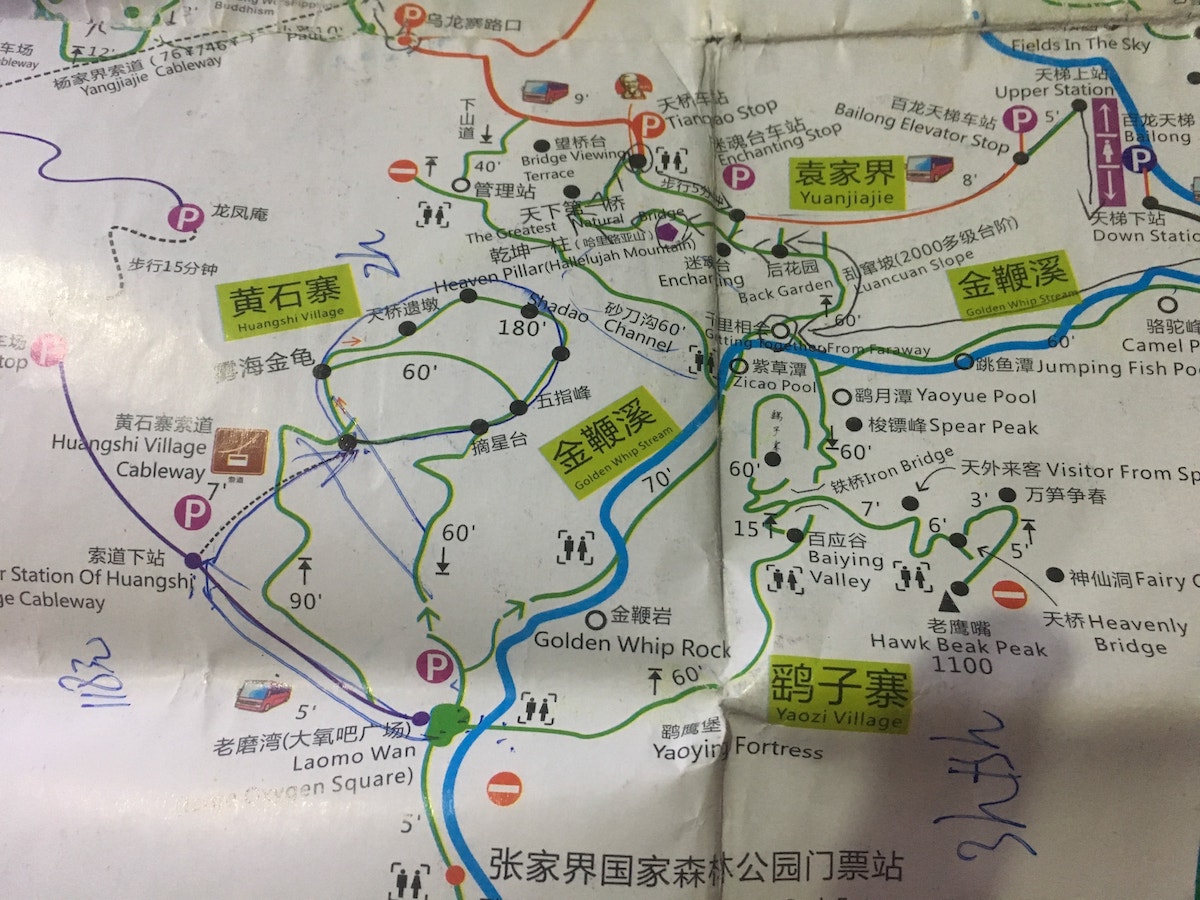
Golden Whip Stream
The beginning of my third and final day at the park mirrored the first one. From the Wulinguian Entrance, I hopped on the bus and after 20 or 30 minutes, got off at ‘Water Winding Four Gates’ (水绕四门). I would be walking along the Golden Whip Stream again. But as opposed to a couple days earlier, I’d complete the entire route before arriving at Huangshi Village.
It was another cloudy day. While things were far from ideal for viewing the sandstone pillars at the top, I couldn’t have hoped for better conditions at ground level. Hovering clouds of mist floated over much of the trail, giving everything a mysterious, fairytale-like feel.

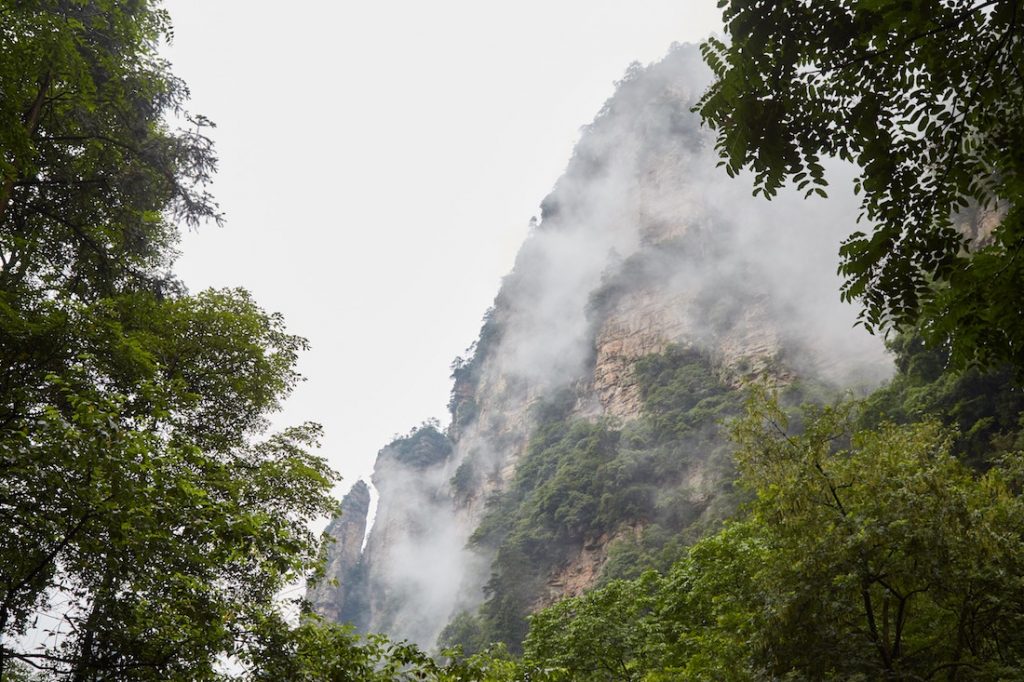

I passed by the same landmarks that I had previously, but rather than ascend up the staircase at Getting Together From Far Away’ (千里相会), I kept on walking. And the farther I got, the less people there were around me.

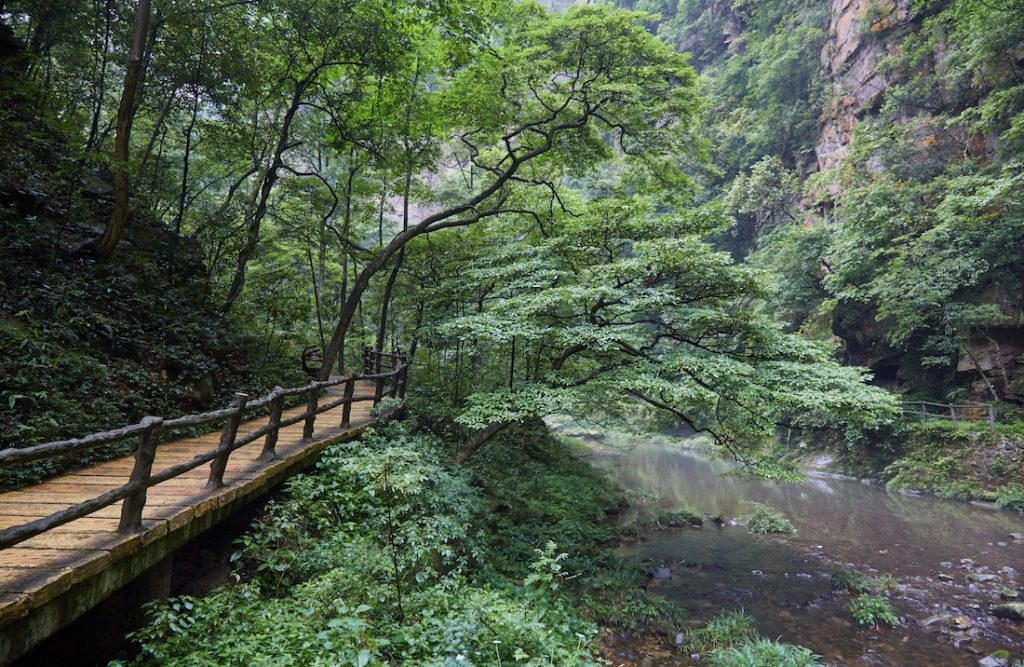


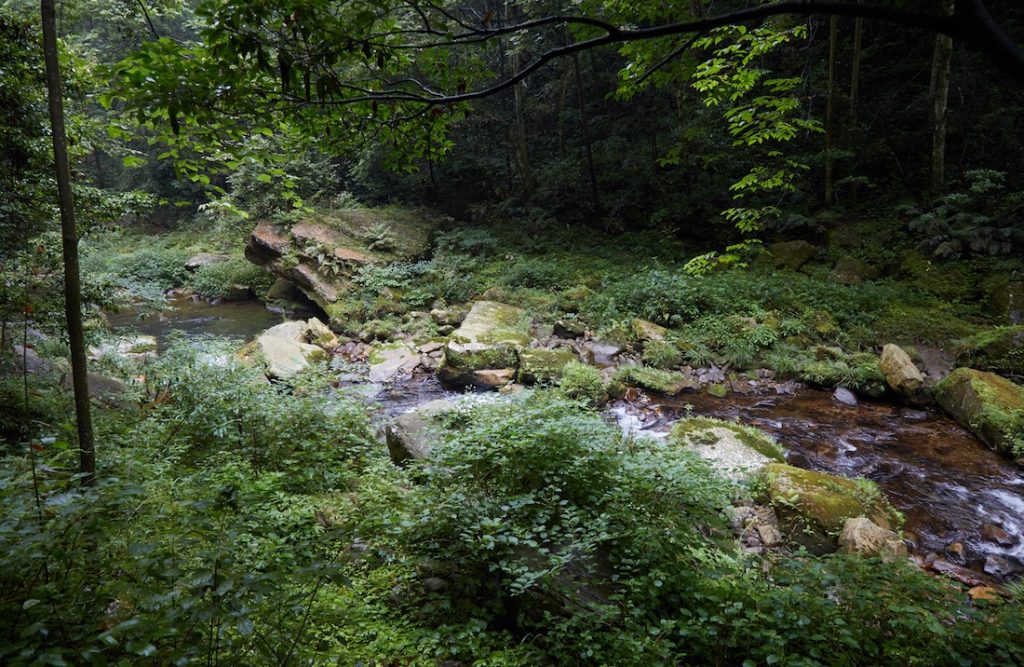
Following the walking path, I sometimes found myself walking right along the stream, while at other times it was out of view. Occasionally, the trail would take me over small bridges to the opposite side of the water.
One of these bridges offered a view of Zicao Pond, a pool of water in which locals would rinse off handmade paper during the Qing dynasty. Under certain lighting conditions, the pond may appear as purple,
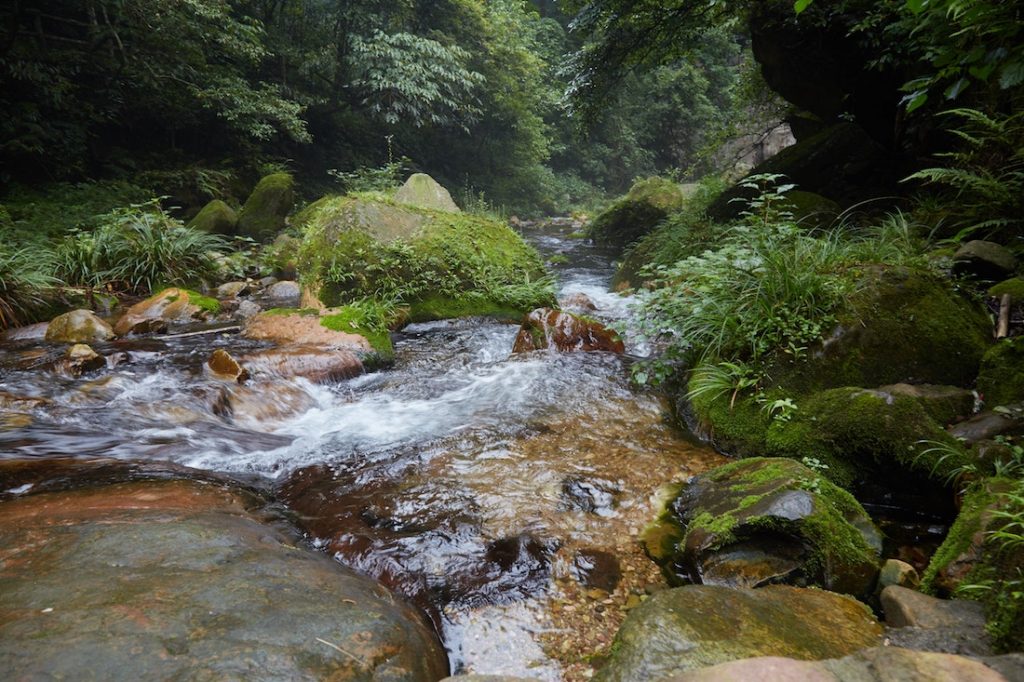
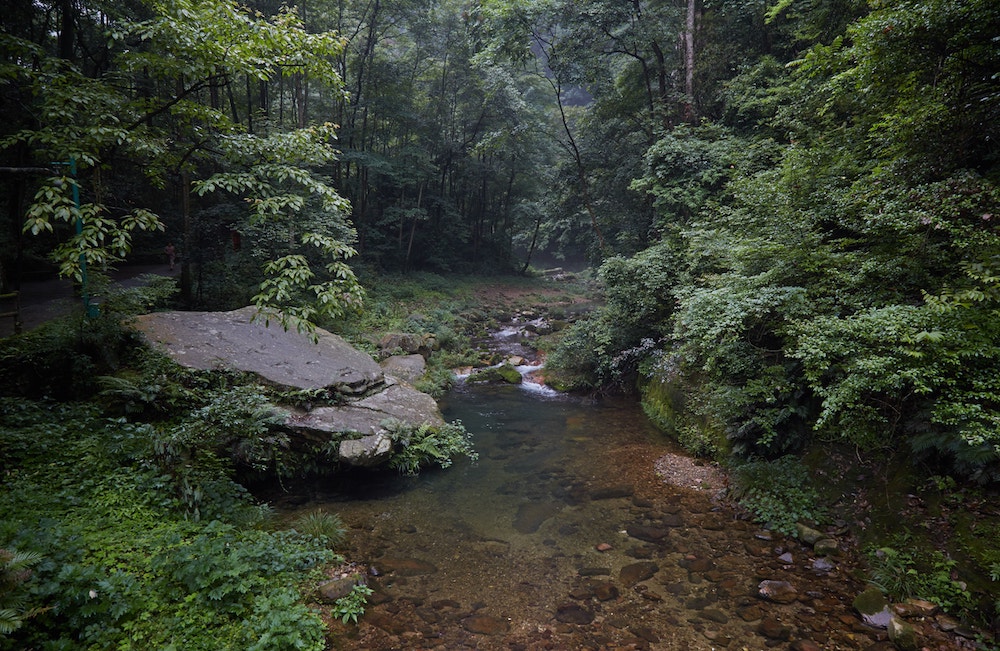

I passed by the base of a relatively small pillar which was a fine example of cross bedding. The overlapping layers and varying patterns of the sandstone, according to the sign, were caused by changes in the water flow as the sediment gradually formed into rock. All this happened, of course, many millions of years ago.


Moving onward, I spotted the ‘Litterateur Rock’ peaking through the trees. From the proper angle, the top portion of the sandstone pillar resembles a face. And the people who named it felt that it resembled a famous author. In particular, either Russian writer Maxim Gorky or Chinese writer Lu Xun, both of whom died in the year 1936.


In an especially quiet, isolated part of the walking path, I encountered the Spring of Longevity. This mineral-rich natural water source, according to local belief, brings health and long life. But with the way the letters are etched in the stone, I almost mistook it for a tomb!
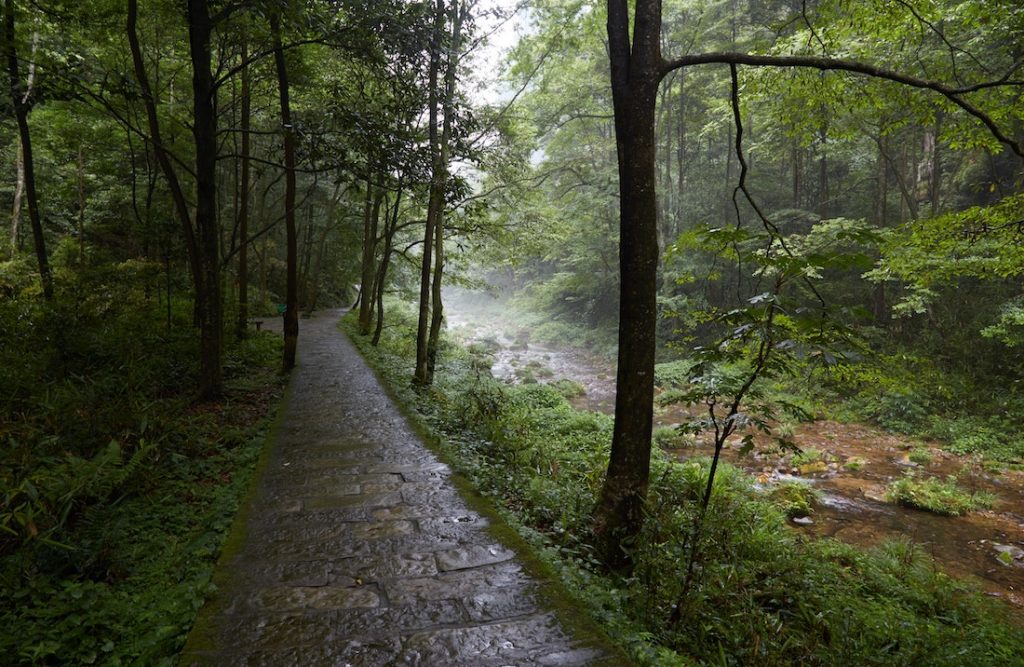

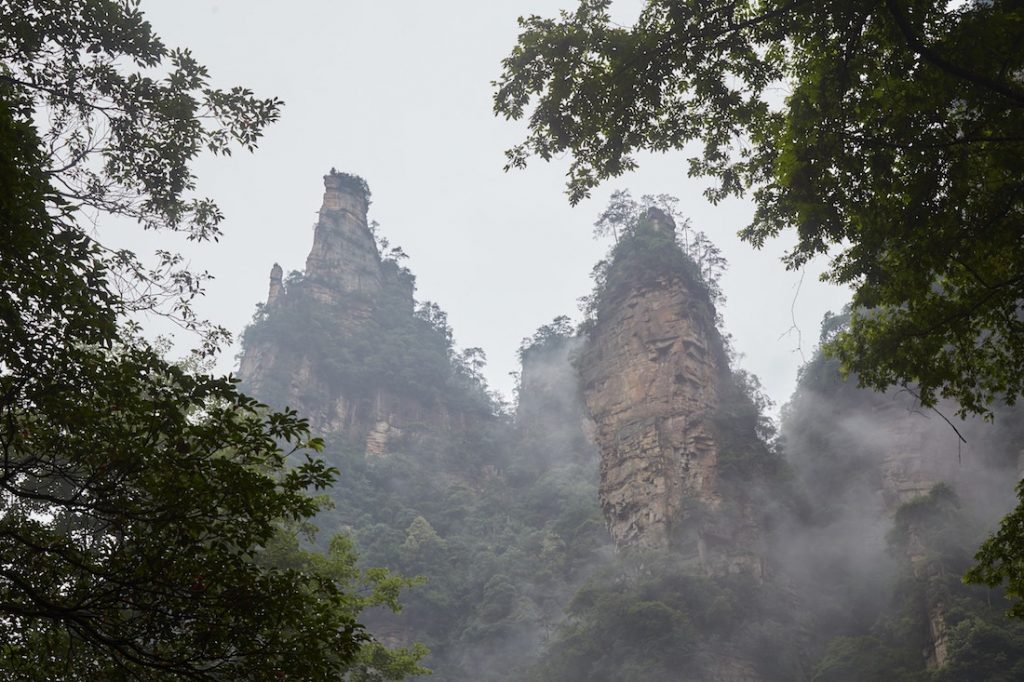
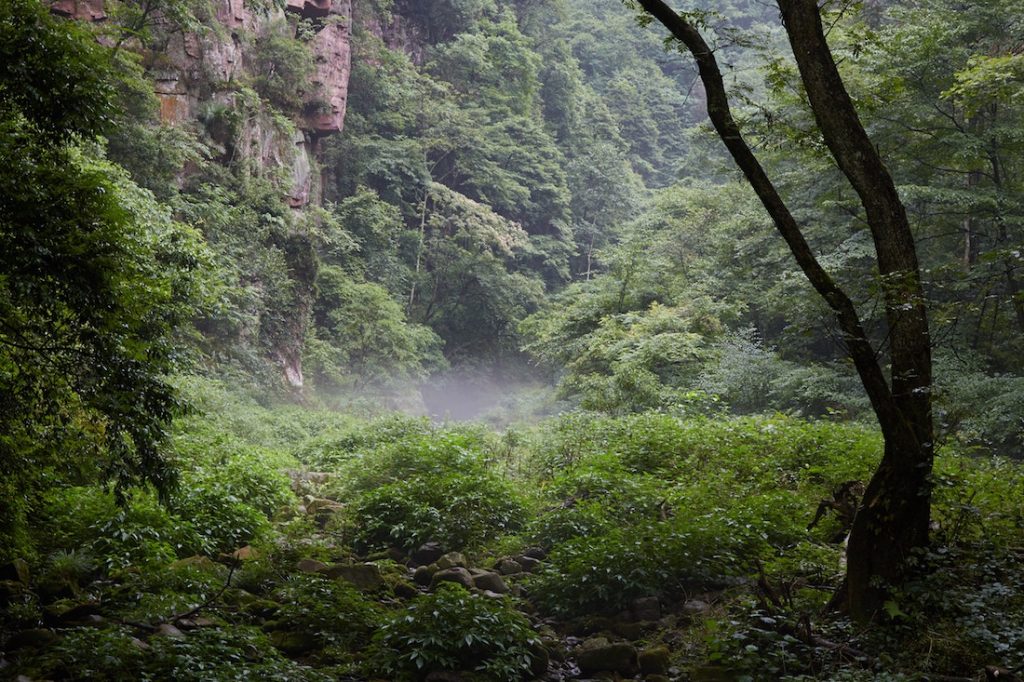
Close to the end of my journey, I passed by the iconic Golden Whip Rock after which the stream was named. Flat on three sides, the pillar is said to resemble a whip. Local legend attributes the whip to one lost by the first Qin dynasty emperor over 2,000 years ago.
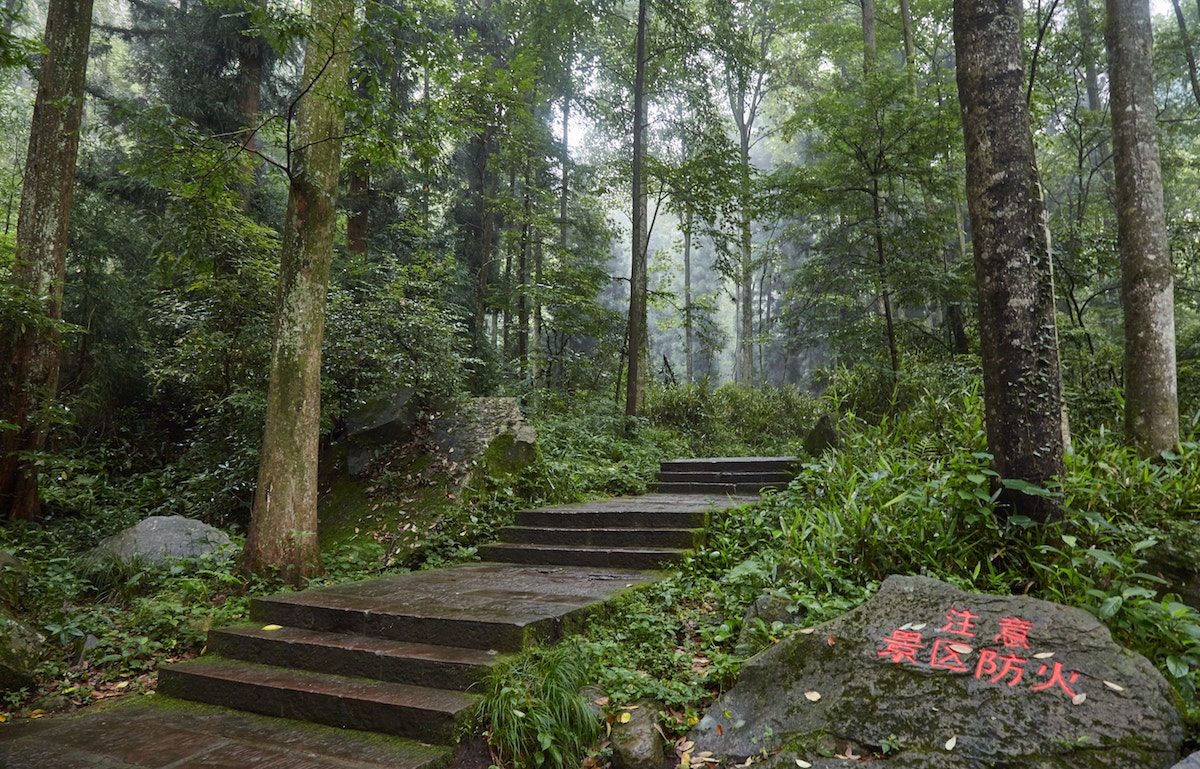
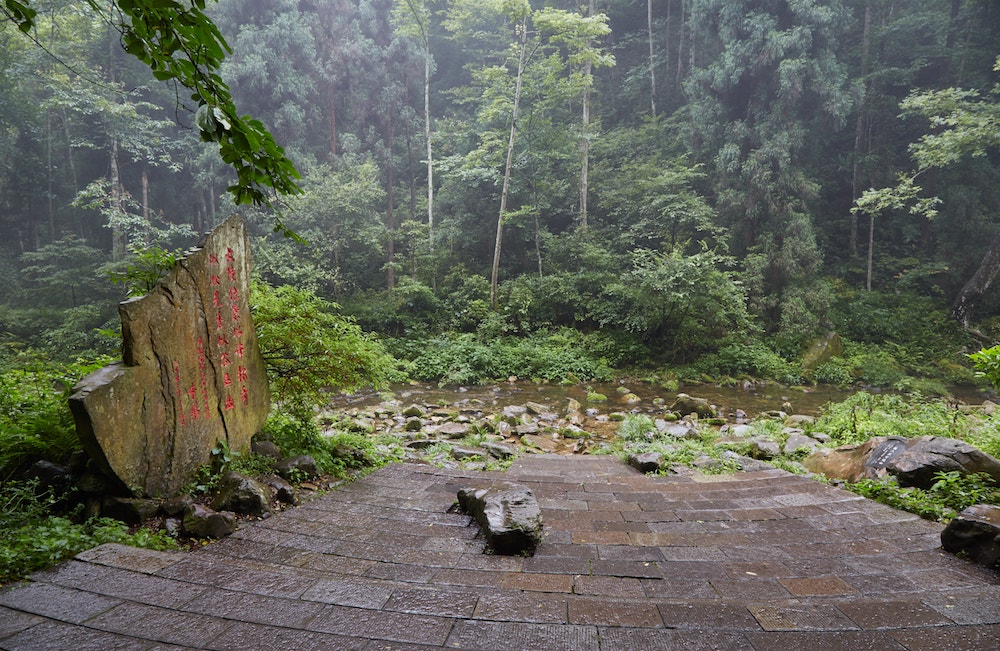

The trail meandered on for awhile, taking me through a forested area, and then back closer to the stream – this time under a covered walkway. And eventually, I arrived at Oxygen Square from where I would start my ascent up to Huangshi Village.
It had been a long walk that took me around two hours to complete. But it turned out to be one of my favorite parts of Zhangjiajie National Forest Park. Until now, the places I’d visited were either exhausting yet quiet or flat but crowded. Golden Whip Stream managed to be a peaceful, easy walk that also took me away from the crowds.
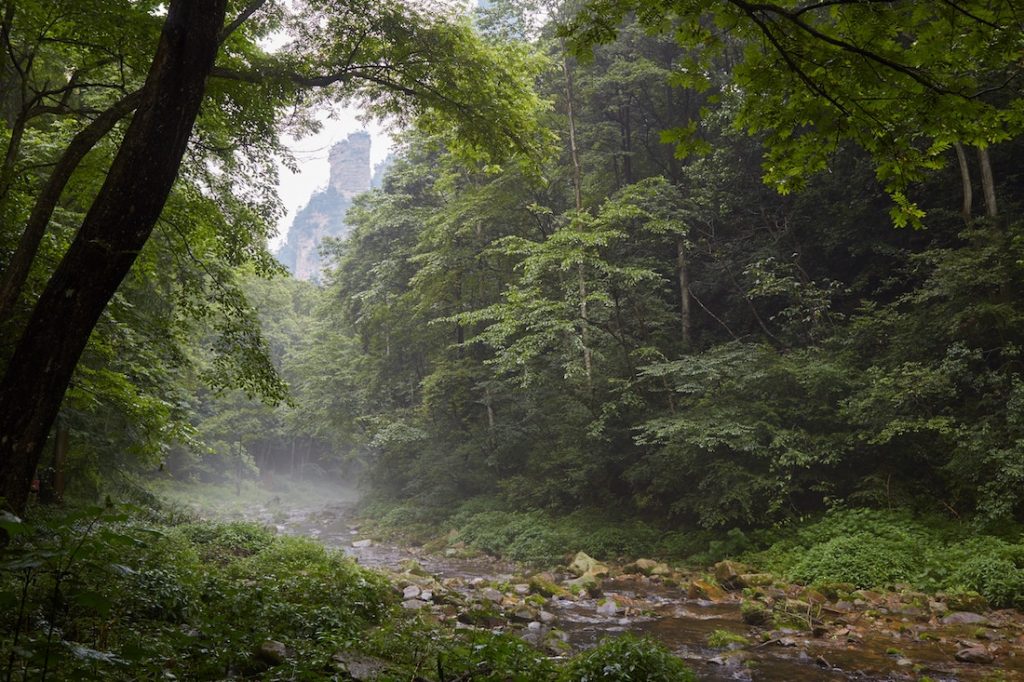

The Ascent
Arriving at Oxygen Square, I was somewhat surprised to find such a large and developed area at the opposite end of Golden Whip Stream. There was a manicured garden and a few small restaurants. But looking at the map, it turns I was right by the ‘Zhangjiajie National Forest Park Entrance.’ While most people stay near Wulingyuan, there are numerous hotels around here too.
I found the trail up to Huangshi Village. As had been the case the last couple of days, I’d find myself mostly alone during much of the ascent. An overwhelming majority of Chinese visitors, it seems, prefer to take the cableway.

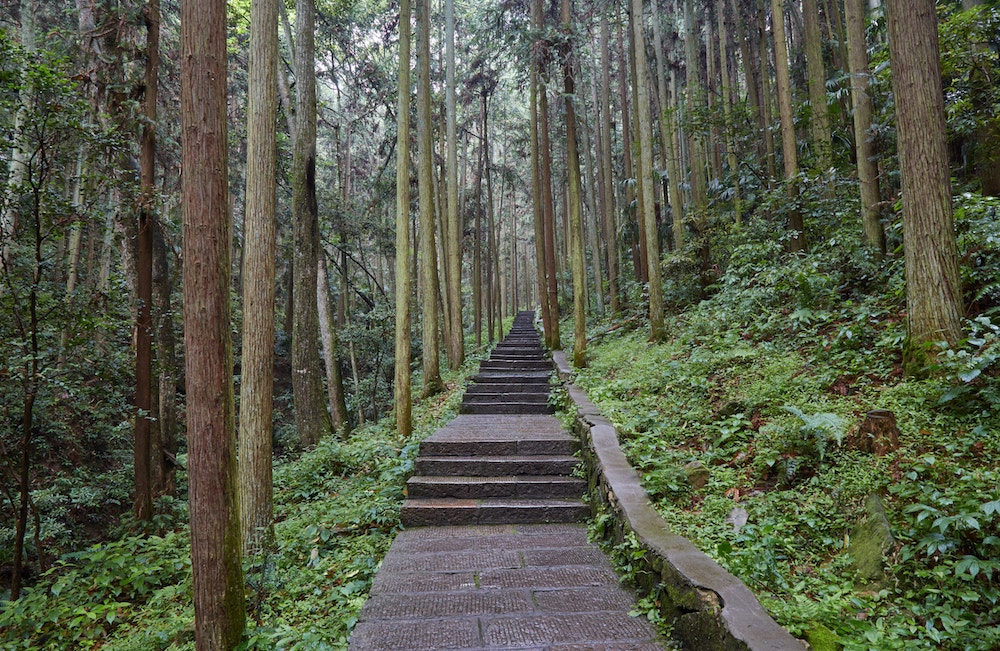
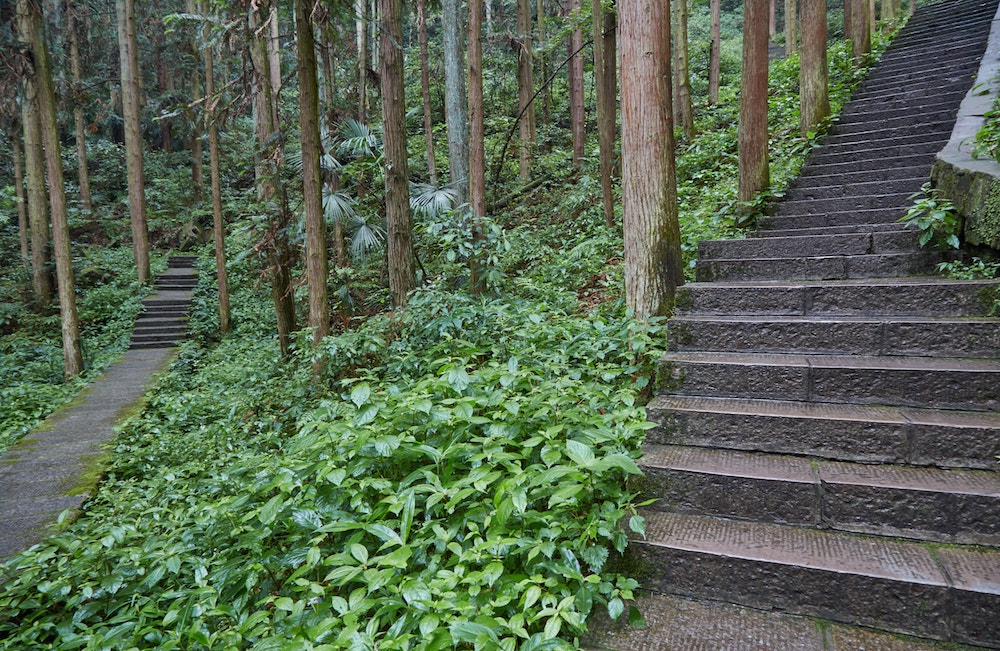

Partway up the mountain, I arrived at a viewing platform called Da Yan Wu which has been carved into the side of a pillar. I rested my legs for a bit while taking in the view of yet more pillars in the distance. But then I turned around to admire the one right behind me.
I’d grown so accustomed to seeing them from afar that I hadn’t really taken the time to observe these rock formations from up close. Looking at the various layers and uneven chunks of rock, it was evident that these things took a very, very long time to form. And to think that the park consists of over 3,000 of them!
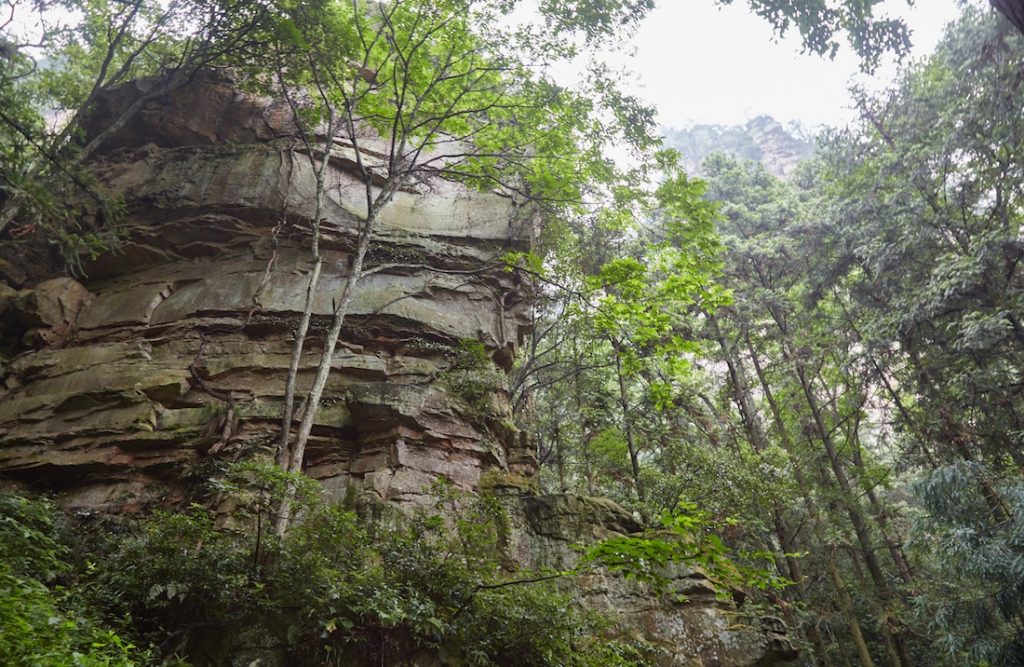
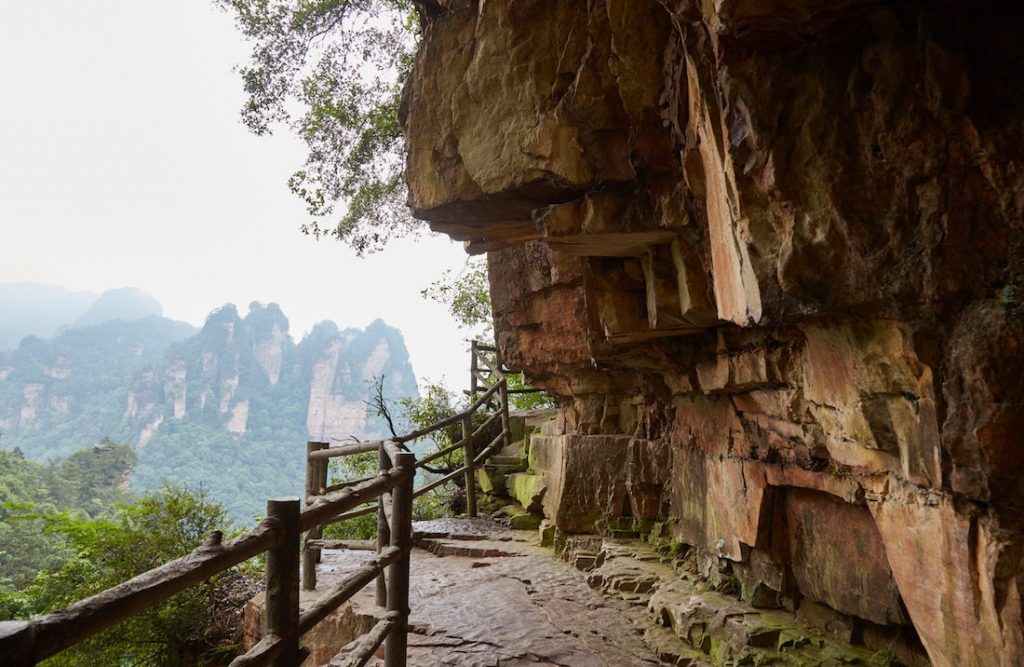

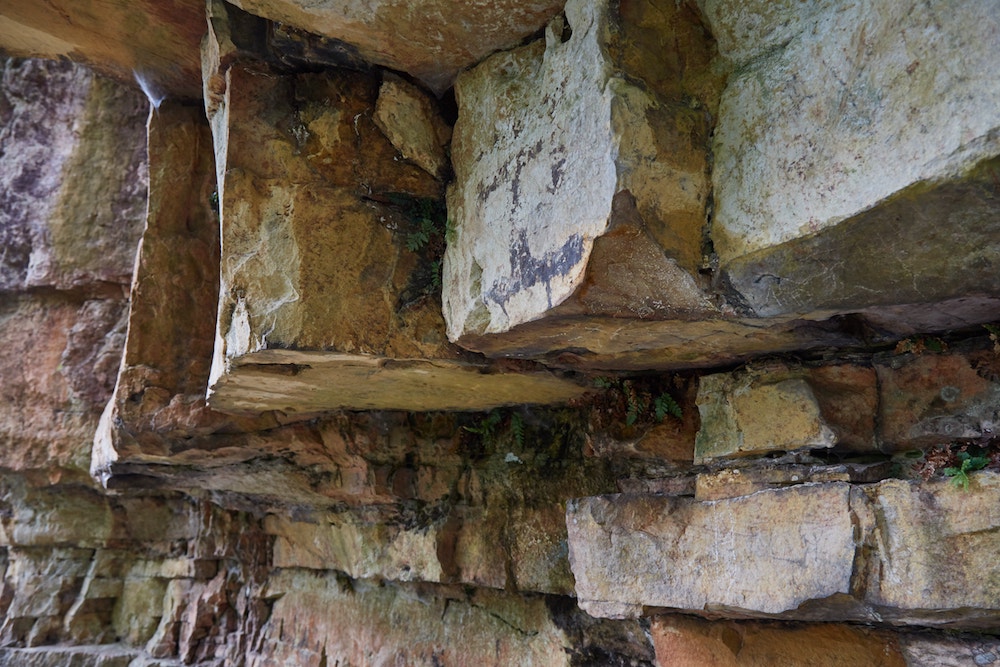

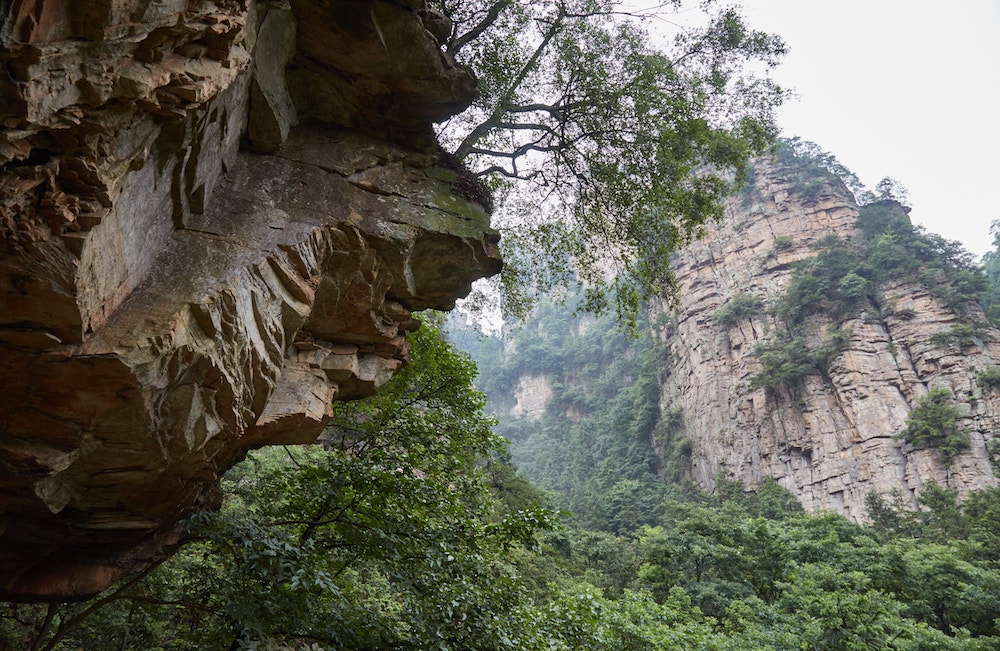
I continued walking up the trail which took me right through the heart of a lush, green forest. While this hike lacks the stunning viewpoints of the others around Zhangjiajie, the trees and plants made for a nice change of scenery. At one point, the trail even took me in between a sandstone pillar which seemed to have been split in half.
The walk was fairly tiring, but not any more so than the previous two days. And it was shorter, too. No more than 70 minutes had passed before I found myself at the upper level of the park, right in the heart of Huangshi Village.
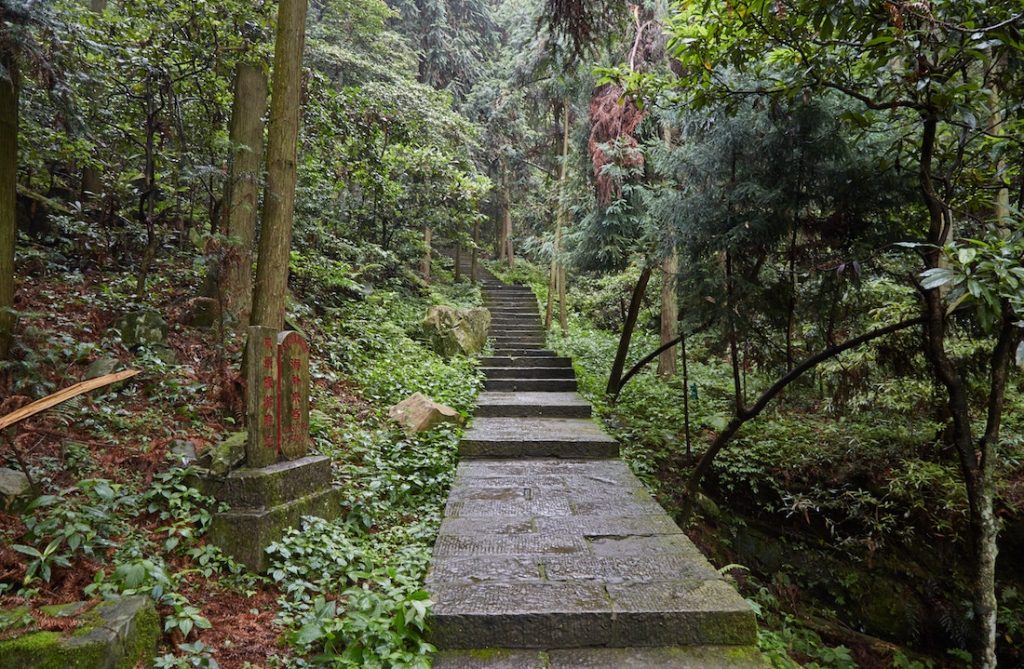
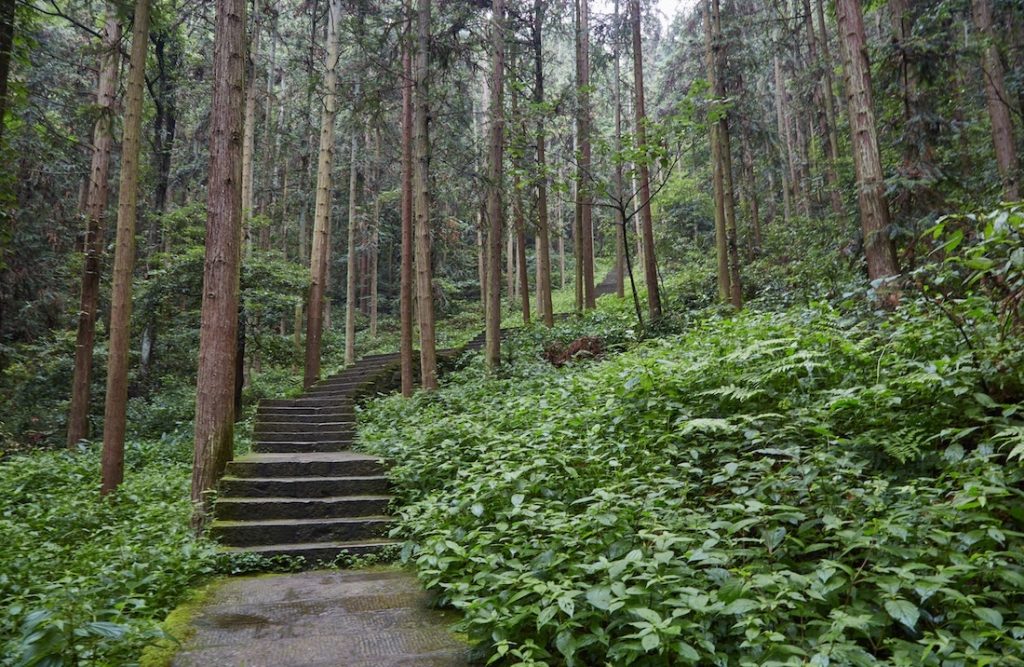



Exploring Huangshi Village
Huangshi Village, or ‘Yellow Stone Village,’ was supposedly named after an ancient Taoist master. But nobody really knows for sure. The whole area can be explored in around 3 hours, and the trail conveniently loops around in a circle. That means that you don’t have to backtrack through the same areas to get back down, unlike Yuanjiajie or Yangjiajie.
Furthermore, there’s also an alternate trail you can take for your descent. You will, however, have to traverse the entirety of the Golden Whip Stream again once back at the bottom!
Online information about the area is scarce, while even my map failed to include most of the landmarks. And so I decided to just enjoy the trail to take things as they came. The first landmark I arrived at was the Star-Picking Platform.



The platform contains an upper and lower level. While there were no benches, I sat atop the rock for awhile to finally rest my legs after three hours on my feet. Hungry, I ate the snacks that I’d brought as I observed the Huangshi Village landscape for the first time. The sandstone pillars here were noticeably thicker than what I’d seen on my earlier excursions.

Nearby, I came across the traditional-looking Sugong Pagoda on the mountaintop. While I couldn’t go inside, I enjoyed the views from the platform outside. The top of Huangshi Village was noticeably much less crowded than those of the other areas I’d visited.
Nevertheless, a nearby tour guide, accompanying a small group of no more than three people, felt compelled to speak through her megaphone on maximum volume! I couldn’t take it for very long and went on to find the next landmark.
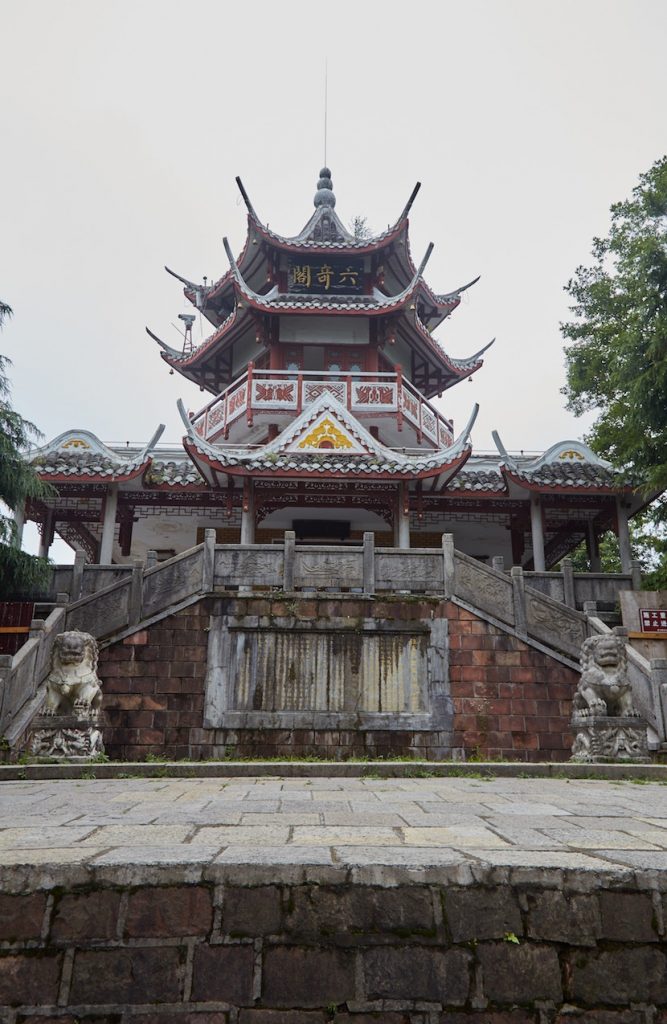
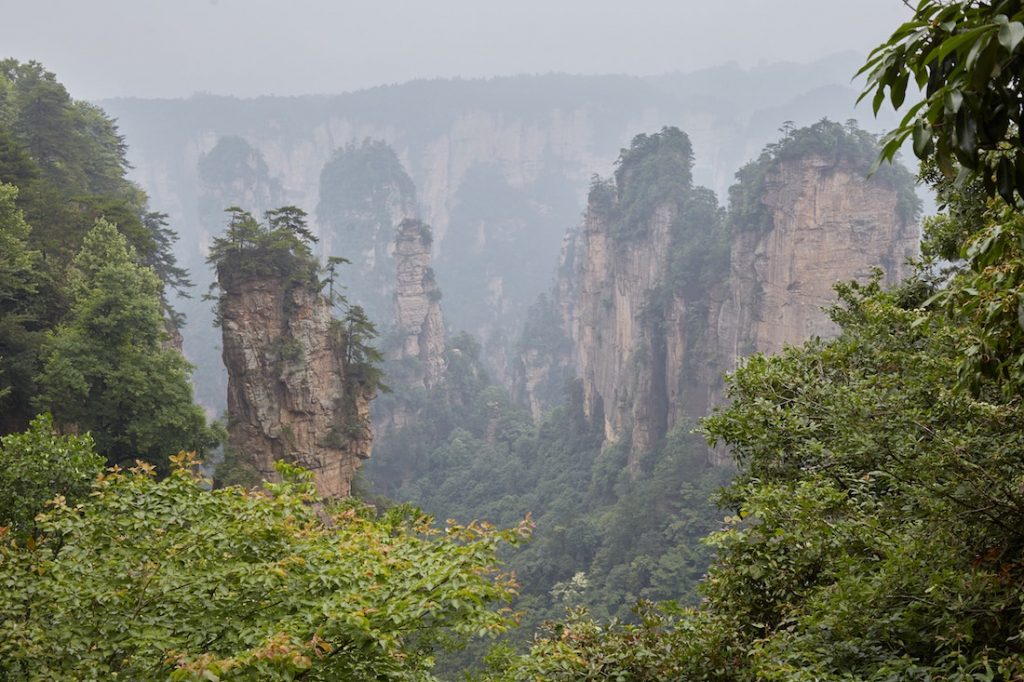
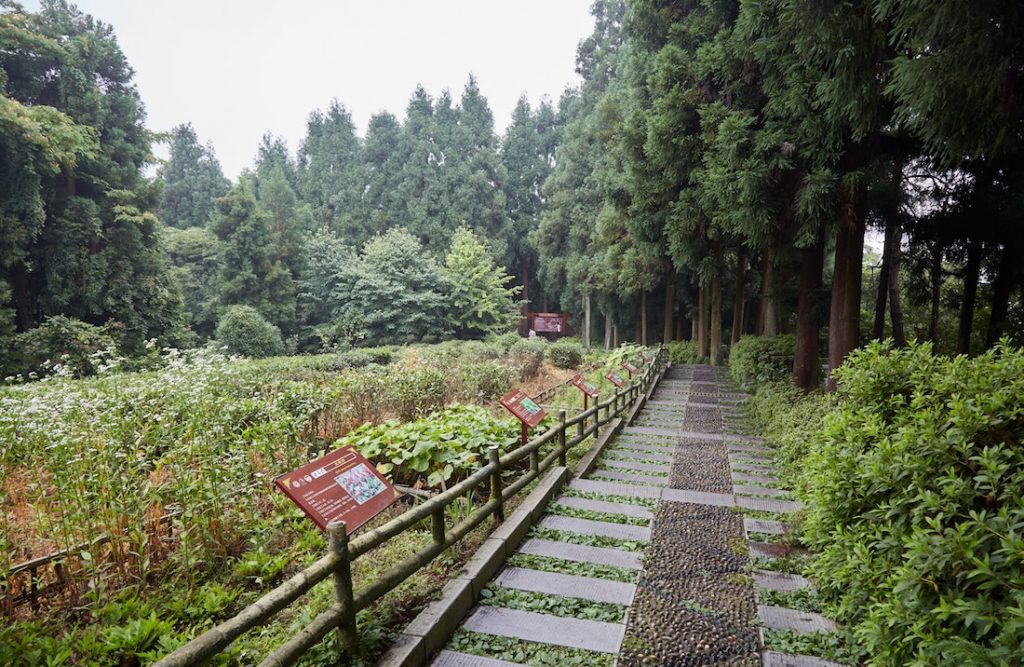
I soon came across something I hadn’t expected to see at this elevation – a garden. A trail took me alongside various plants and flowers before I arrived at the next scenic vantage point, Boar Rock.
I presume that the rock was named after a likeness to a certain animal, but I couldn’t really see the resemblance. In any case, it was an impressive view.

Making further progress along the loop, I arrived at one of Huangshi Village’s most notable landmarks; Five Fingers Peak. This one was pretty self explanatory. The group of five narrow pillars really did remind one of a giant’s hand sticking out through the earth.
At one point, the trail split into two. And with little signage in the area, I wasn’t quite sure which to choose. One of them, it seems, cuts right through the loop rather than around it, and so I opted for the longer route. The trail I chose took me to some stunning viewpoints of the Echoic Cliff and Jade Vase Peak.
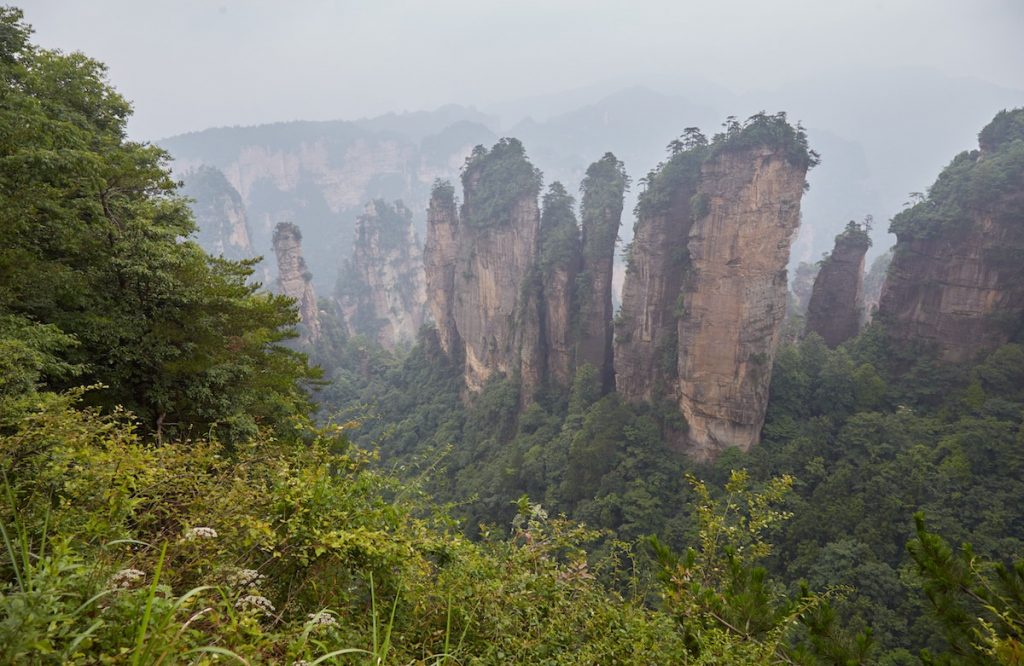


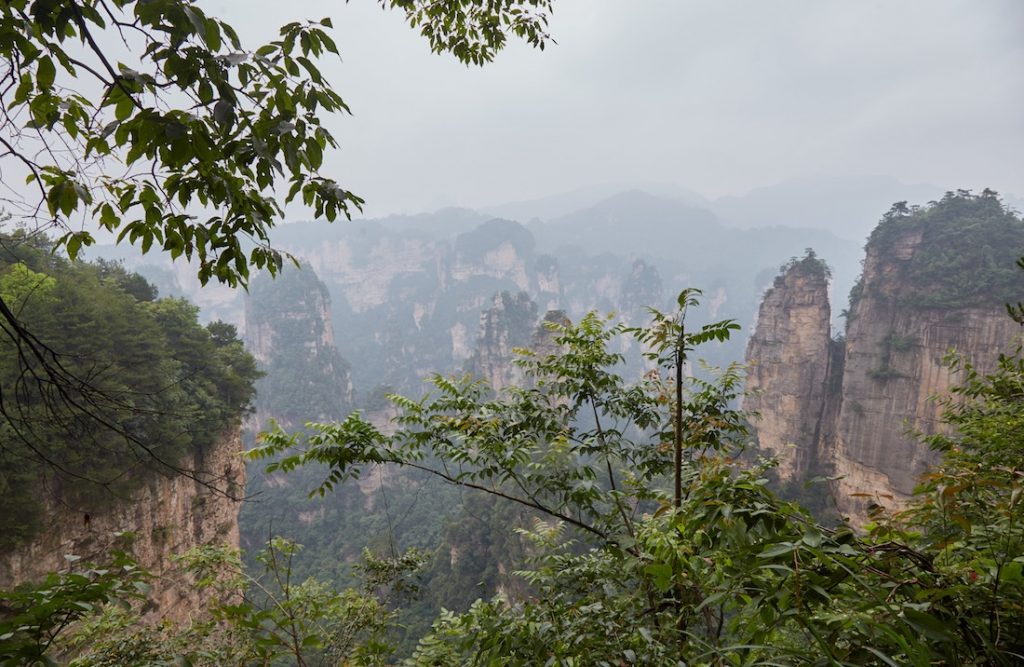
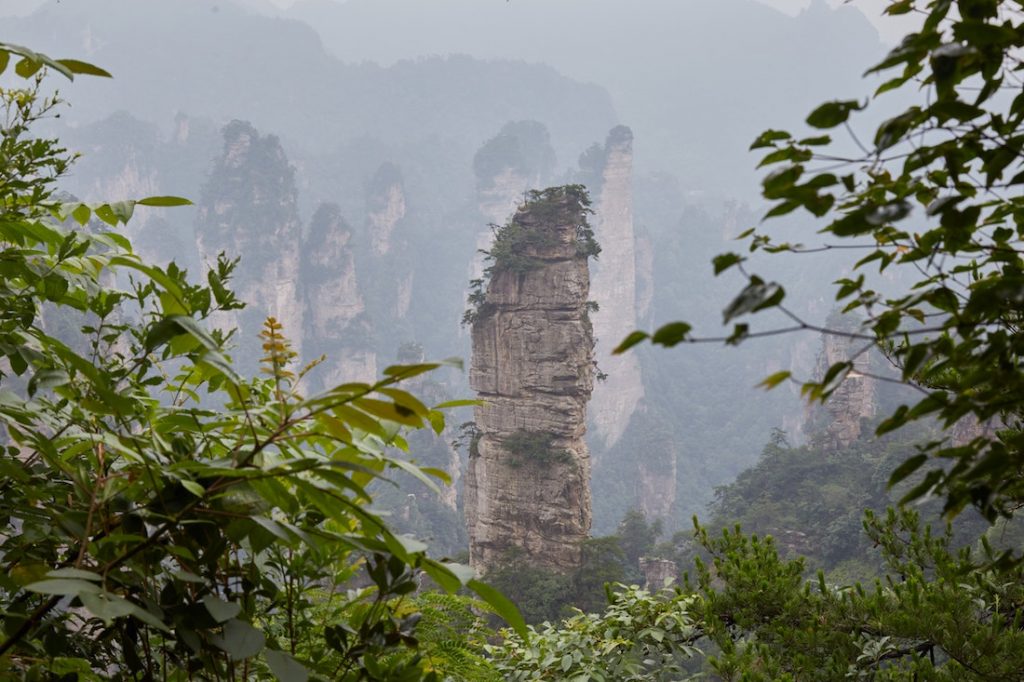

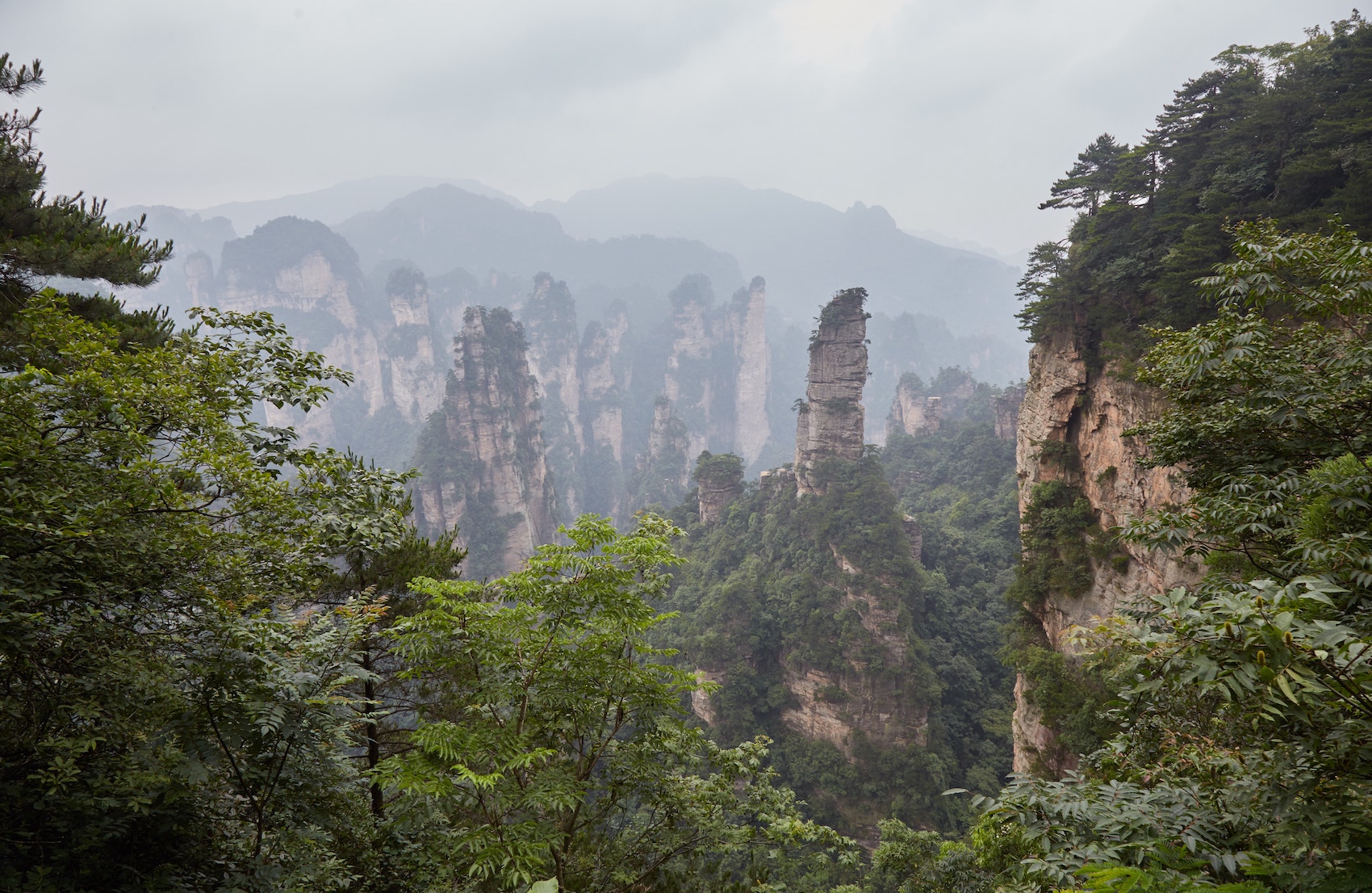


One thing Huangshi Village has more of than any other area of Zhangjiajie is monkeys. Some of the paths are entirely full of them. And while they’re the same macaques commonly found all throughout Asia, some of the ones I saw in Huangshi were among the biggest I’d ever seen.
Generally, they won’t bother you unless you don’t bother them. That is, unless they realize you have food. At one point during my hike, I heard screaming in the distance. I looked behind me and saw a girl running past me. Some moments later a monkey, hot on her trail, came speeding after her. And he wouldn’t leave her alone until she emptied the entire contents of her snack bag!
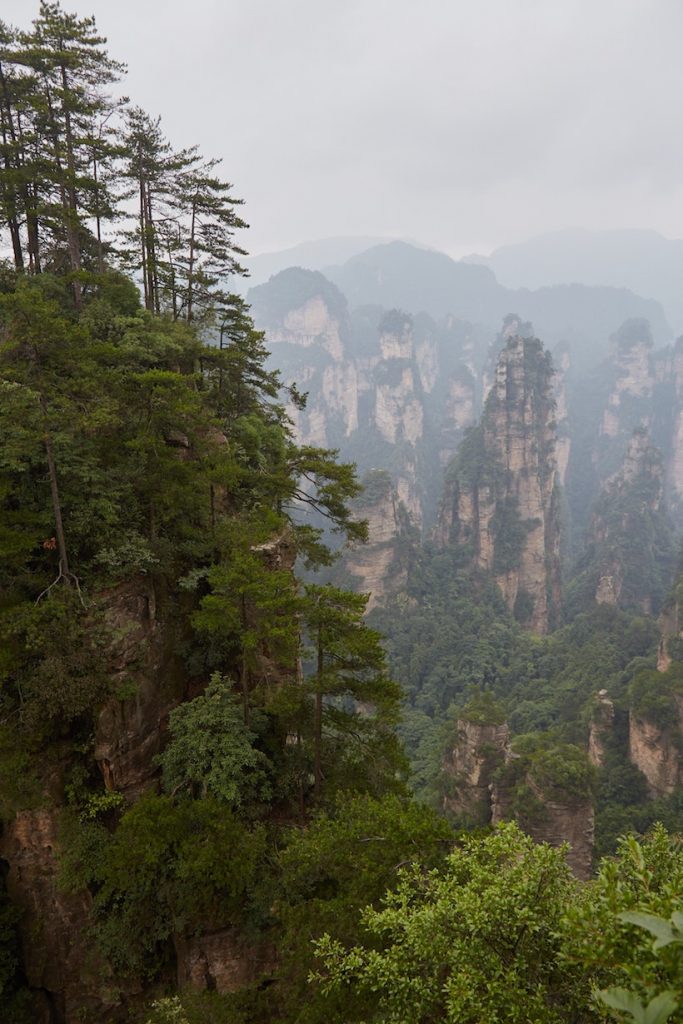
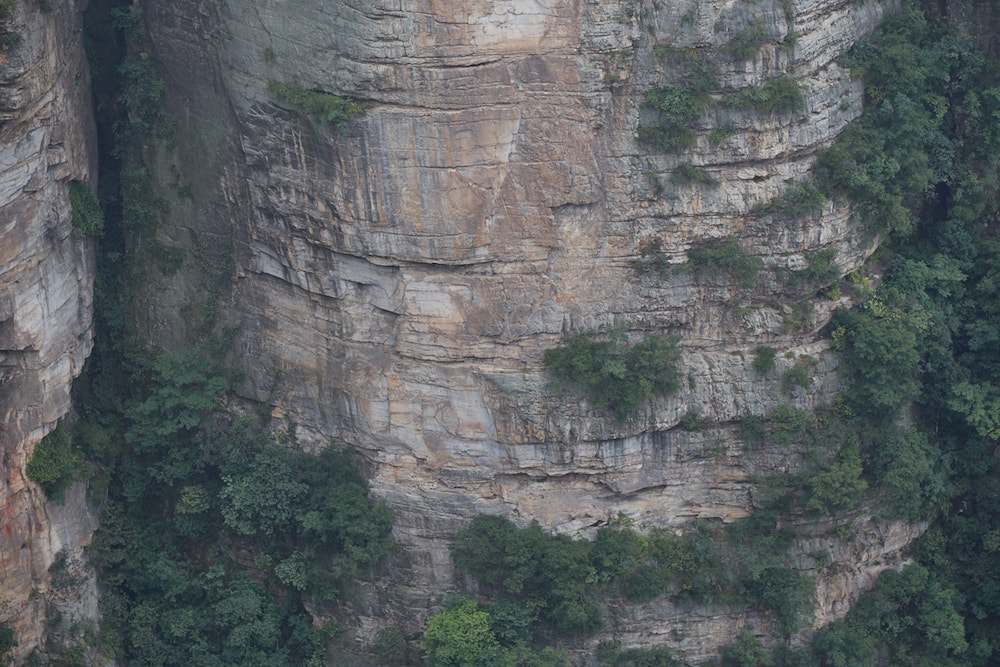

Continuing around the loop, I came across landmarks like ‘Mounds Left From the Heaven Bridge’ and ‘Flying Cloud Cave.’ Disappointingly, the sky never cleared up. And while I was able to make out the shapes of the pillars in the distance, the cloudy sky and the haze certainly put a damper on the experience.
But I can’t really complain. Later on in my Hunan trip, I met some travelers who told me that they couldn’t see a thing during their entire time at Zhangjiajie National Forest Park. While I think 2 full days are enough to experience the park, make plans for at least three. You never know quite how things are going to turn out weather-wise.
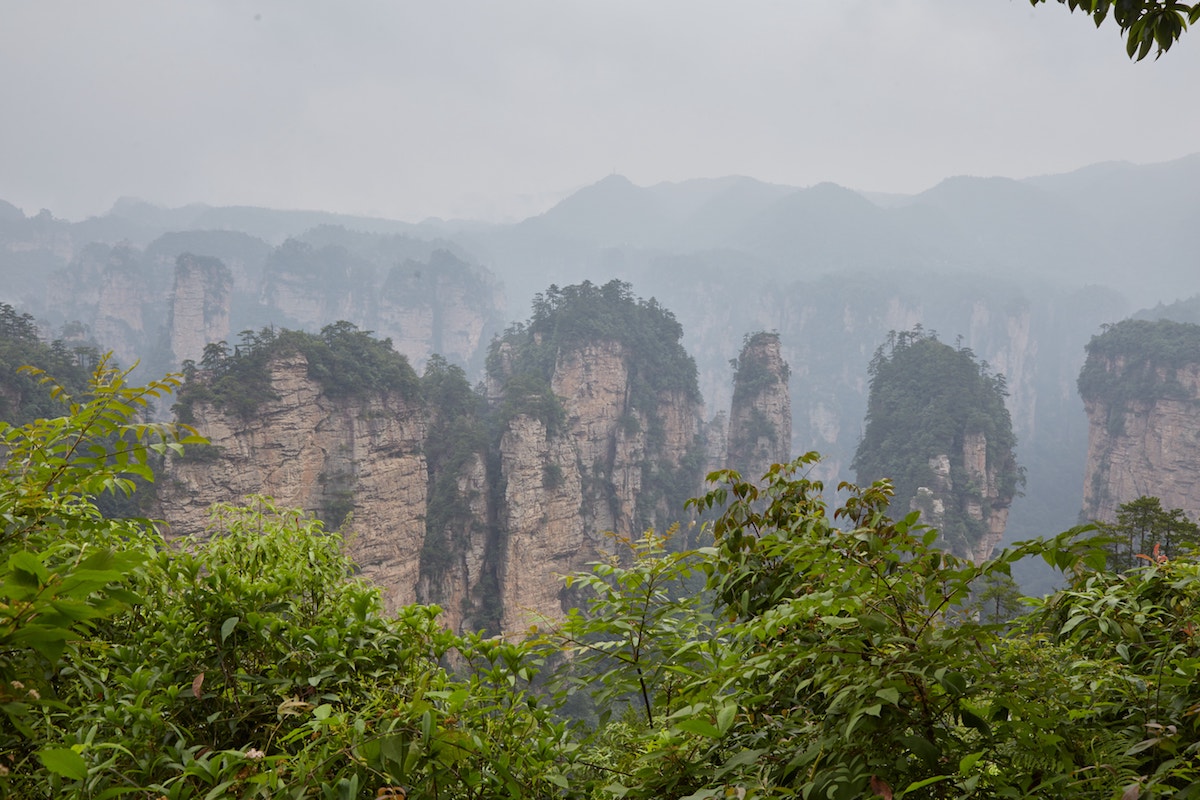

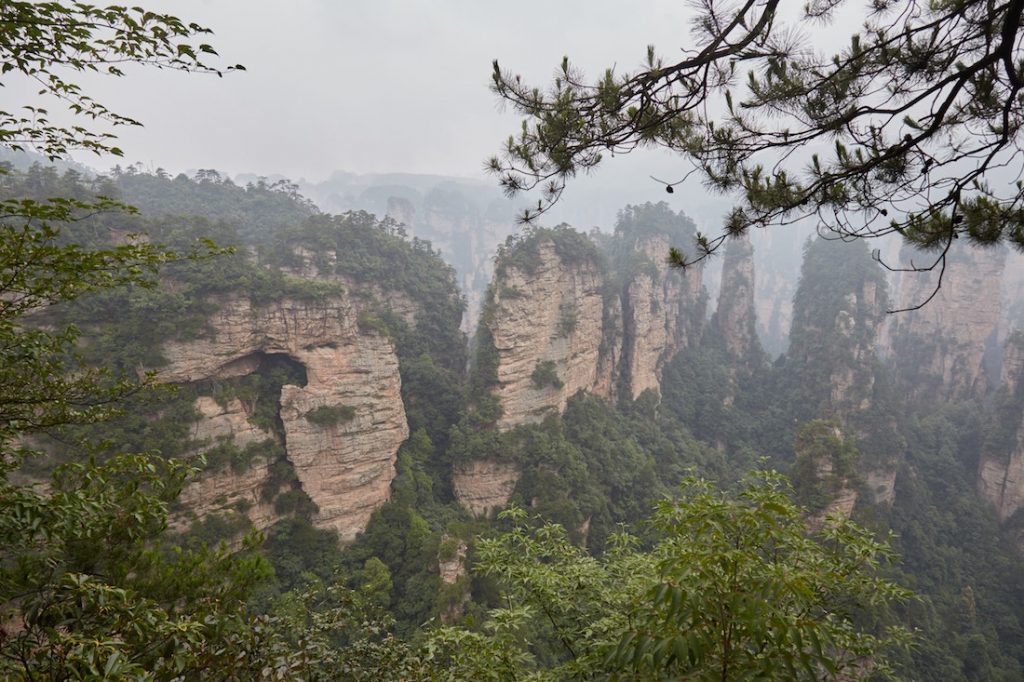
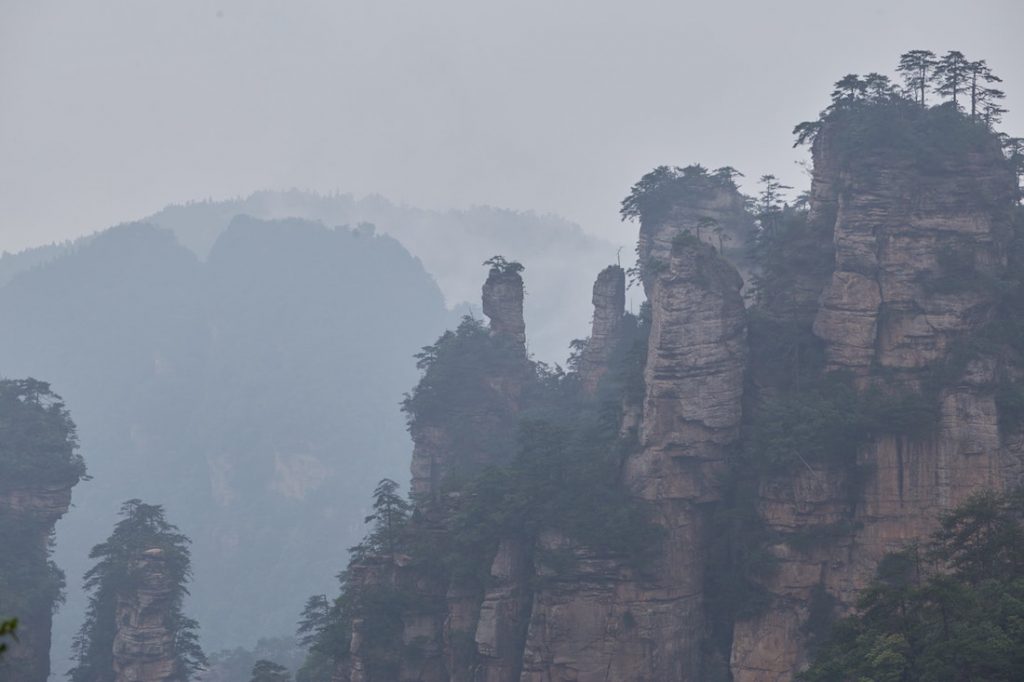
Huangshi Village is mostly flat at the top, and the journey wasn’t too strenuous. A few hours later, I realized that I completed the loop. Or at least about 80% of it, as the alternate path down begins west of the Star-Picking Platform where I first arrived. Spotting the staircase downward, I took in some final views from the top before starting the trek back down.


Back Down
The hike down was scenic, but relatively uneventful. At least until the end. Close to the bottom, the flat paved trail ended and was replaced by an uneven collection of rocks. This would’ve been no big deal had it not been lightly raining. The rocks turned out to be extremely slippery.
What would’ve normally been a five minute walk turned into 20 or 30. Taking my time, I managed to survive without getting hurt (or worse, breaking my camera!), but I had a few close calls.
I arrived at the bottom, only to find myself in the middle of nowhere. Looking at the map, I was somewhere near the bottom station of the Huangshi Village Cableway. I was hoping to find the end of the Golden Whip Stream trail, but realized I had to take a bus just to get there.
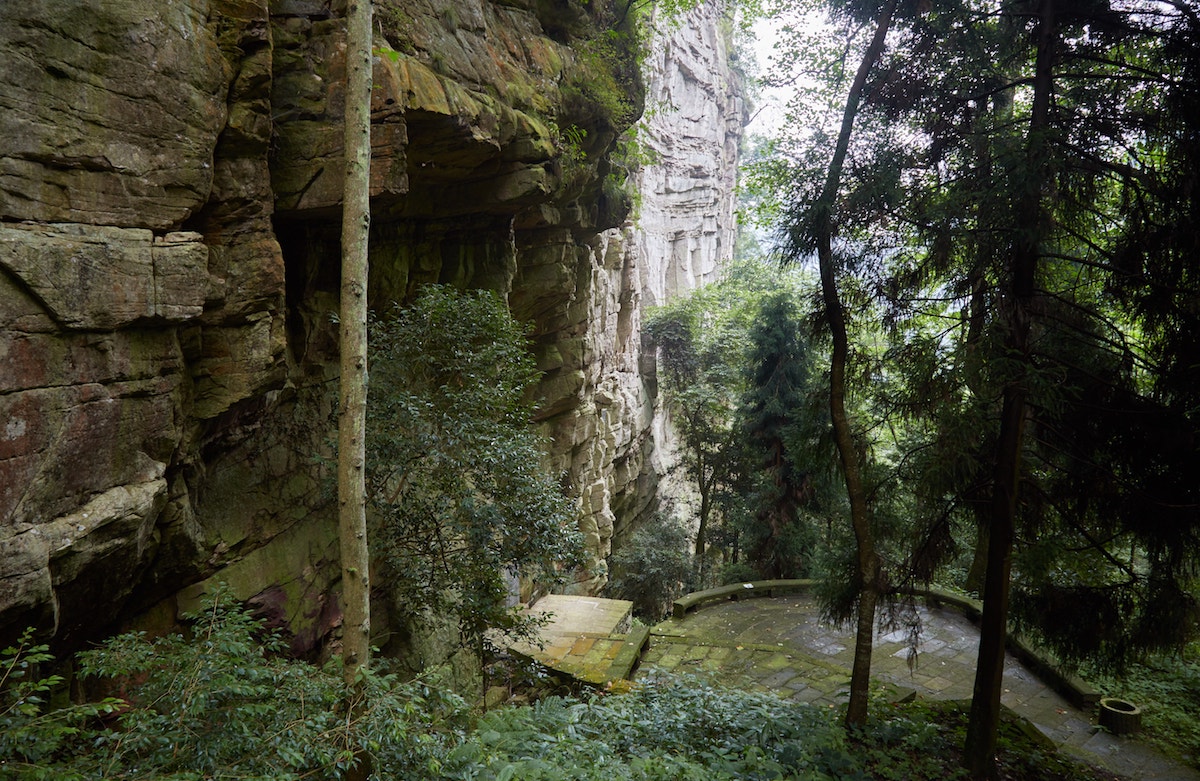
Luckily, getting a seat was no problem. I waited in the nearly empty bus for 15 minutes or so before it finally departed. I was once again back at Golden Whip Stream, through which I had to make the 2 hour walk again to get back to ‘Water Winding Four Gates.’
It turned out to be at least three, however, as I got stuck in a couple of downpours. I finally made it to the bus, soaking wet. And after returning back to my hostel, I took a much needed shower.


Is Huangshi Village Worth the Hike?
If you’ve read all three sections of this Zhangjiajie National Forest Park Guide, you’d be right in assuming that Huangshi Village is the least remarkable of the three itineraries covered. (Despite this, a sign near the entrance reads: ‘Those who miss hiking Huangshi Village need not bother coming to Zhangjiajie.’)
But is it worth hiking at all? If you have an extra day, then yes, I would recommend it. You may be tempted by the other attractions that the general Wulingyuan Scenic Area has to offer. These include Baofeng Lake, Yellow Dragon Cave and the massive glass bridge. Understand, though, that these all require separate admission tickets and are not covered in your multiple day pass for the park.
While I haven’t been to these extra attractions myself, reviews online make them out to be overhyped tourist traps. Therefore, I’d stick with somewhere within in the park itself, especially since the pass is valid for multiple days.
There are also some additional areas of the park that I didn’t cover, such as Tianzi Village. Should I ever return to the park some day – and I really hope that I can – I’ll be sure to expand the guide to cover these other areas.

Additional Info
Planning a trip to see Hunan Province’s various national parks can be confusing. In addition to Zhangjiajie National Forest Park, there’s also Tianmen Mountain which is accessible from Zhangjiajie the city. So which is which?
Zhangjiajie City is the largest city in the general area. It used to have a different name, but the Chinese government renamed it once Zhangjiajie National Forest Park started to become popular. However, the closest town to Zhangjiajie National Forest Park park is not Zhangjiajie City, but a small town called Wulingyuan.
The two towns are about an hour apart. And while I’d definitely recommend seeing both, you should book separate accommodation in each city to make the most of your time. At either park, it’s best to start your day as early as possible.
As mentioned, it’s best to stay in the town of Wulingyuan and not Zhangjiajie City when visiting Zhangjiajie National Forest Park.
I stayed at Zhangjiajie 1982 Chujian International Youth Hostel during my trip and would recommend it. While I normally avoid staying in shared dorm rooms, I make exceptions for national park areas. I was able to sleep pretty well each night and met a number of friendly Chinese and foreign tourists alike.
Other positives include the staff being quite helpful with setting guests up with a park pass and explaining the best routes to take. And most importantly, the hostel is an easy walk from the Wulingyuan Entrance of the park so you’ll have no issues getting there and back each day.
But some of the downsides include booking a room that was advertised as 4 people max, only to check-in and discover 8 beds! Fortunately, though, this didn’t turn out to be a big deal, as it wasn’t always full and the other guests were friendly. Another annoying issue was the lack of a washing machine in the building. They actually make you walk all the way to one of their sister establishments if you need to wash your clothes.
Note that this place also has private rooms if you’re alone or traveling as a couple. And there are of course many other accommodation options around Wulingyuan, a town that pretty much just exists for visitors to the park.
But what about staying inside the park itself? Apparently this used to be possible several years ago, but this was no longer the case at the time of my visit. (Rumor has it that authorities banned park accommodation after part of a trail collapsed.)
With that said, there do appear to be some hotels still secretly operating within the park, which I came across by accident during one of my hikes. Furthermore, there were a number of elderly ladies along the trails mentioning that they had places where I could sleep, but due to the language barrier, I couldn’t get much detail.
So while it may technically possible to stay in the park, I’m not sure how you could arrange this without speaking Chinese.
Wulingyuan has a small bus station. It’s possible to ride there directly from Changsha, which takes 4 hours. However, there are only a few buses running a day. You can also ride directly to and from Fenghuang, but again, there are only a couple buses a day.
Most people will be getting to Wulingyuan via Zhangjiajie City. Buses run very frequently, around every 10 minutes or so, from early morning until 20:30 at night. The ride lasts 70 minutes and costs ¥20 RMB. There’s no need to wait in line at the ticket counter, as you can just pay on the bus.
How to Get to Zhangjiajie City:
Zhangjiajie is accessible from Changsha by either bus (West Bus Terminal) or by train, and the journey lasts about 4 hours. It costs around ¥120.
Zhangjiajie is also reachable by (normal speed) train from many other major cities in China, but given the country’s size, it could be a very long trip. It’s best to take a high-speed train to Changsha first, spend a couple days there, and then head to the national parks from there.
The city is also home to the Zhangjiajie Hehua Airport, which has flights to many major cities throughout China.
As you may or may not be aware, a bunch of major web sites are completely blocked in China. This includes Google, YouTube and social media sites like Facebook. Not only can this be a huge annoyance, but not being able to access your Gmail account or use Google Maps could even cause major problems during your trip.
That is, unless, you have a VPN.
VPN stands for Virtual Private Network. Using one allows you to access the internet via servers in a variety of international locations. Therefore, when traveling in China, you can access the internet through a server in Taiwan or Hong Kong (or anywhere, really) and suddenly start using Google and social media apps like normal again.
I’ve tried out a couple of different companies over the course of multiple trips, and have found ExpressVPN to be the most reliable.
The actual use of VPN’s in China isn’t illegal in itself. However, the Chinese government will often make things difficult for certain VPN companies, and some services may stop working for you out of the blue. That’s why it’s important to go for the most reliable VPN, and ExpressVPN is widely regarded as the best to use in China.
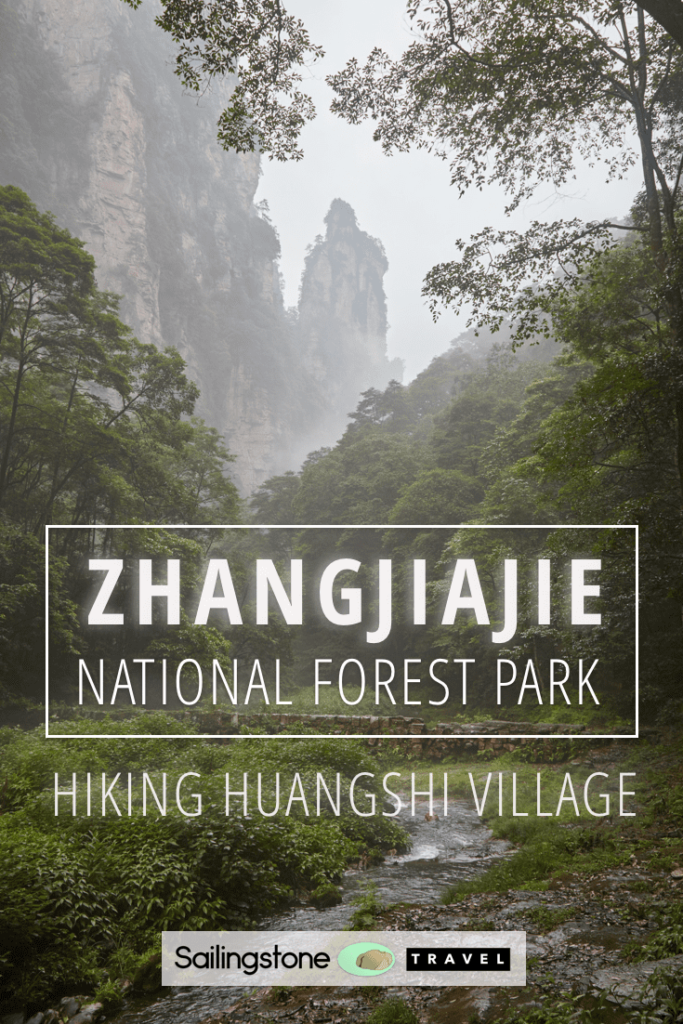
Pin It!

Is it possible to do the trail backwards, i.e. taking a cable car up to Huangshi Mountain, doing the loop and then go down to do the Golden Whip route? It seems more logical and less strenous since one only has to walk the Golden Whip once.
May I know which staircase/trail I should take if I don’t want to end up at the bottom section of the Cable Car Station but go directly to Golden Whip?
Thanks very much for your guides. They are much more detailed than most.
Hi Will, I’m glad you’ve find these guides helpful. While several years have passed now and my memory of the details is a bit hazy, it does seem that in any case, you would have to walk along Golden Whip Stream twice, as the bus in this area seems to only run in between the Cable Car Station and Oxygen Square (both situated after Golden Whip Stream).
You could still take the Cable Car up and walk down, but you wouldn’t be able to skip doing Golden Whip Stream twice.
I could be wrong, however, or perhaps some things have changed in the past five years. So I’d recommend double-checking at your hotel.